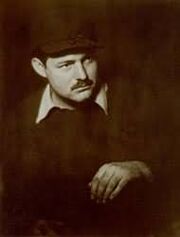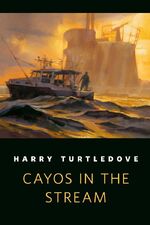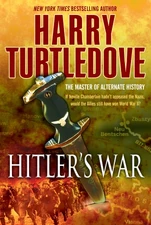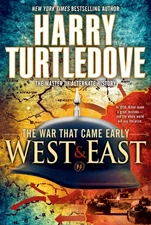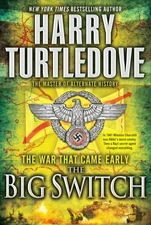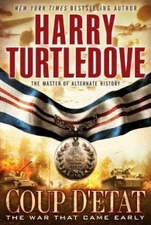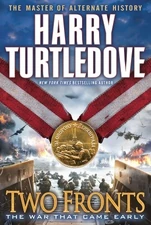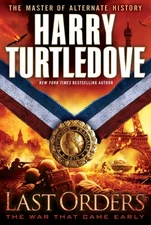| ||||||||||||||||||||||||||
Ernest Miller Hemingway (July 21, 1899 - July 2, 1961) was a novelist, short-story writer, and journalist. He was part of the 1920s expatriate community in Paris, and one of the veterans of World War I later known as "the Lost Generation." Many of his works are now considered classics of American literature.
Later in life, Hemingway acted as a war correspondent in both the Spanish Civil War and World War II. After the publication of several successful books during the course of the 1950s, Hemingway, facing substantial physical and mental health problems, committed suicide in 1961.
Note on "Running of the Bulls"[]
"Running of the Bulls" is Harry Turtledove's science fiction retelling of Hemingway's The Sun Also Rises. It features numerous characters and places that have direct analogs in the Hemingway novel.
Ernest Hemingway in "Cayos in the Stream"[]
| "Cayos in the Stream" POD: c. July, 1942 | |
| Type of Appearance: | Direct second-person narrator |
| Occupation: | Writer, Sportsman |
| Military Branch: | Pro-USA naval vigilante (World War II) |
To get away from a marital life with Martha Gellhorn that was filled with love at first but was now marred by arguing, Ernest Hemingway decided to go hunting for German submarines off the coast of Cuba in his fishing boat, the Pilar in 1942. Using various connections he had in the United States government, Hemingway was able to outfit the Pilar with several pieces of equipment designed to detect submarines, as well as firearms.
After a period of fruitless search, Hemingway heard rumors in Havana of unusual activity near Cayo Bernardo. He ordered the Pilar there, after a period of casual search, a U-boat appeared. Hemingway bought his ship time by requesting aid from the boat and identifying himself. The skipper, who spoke English and knew Hemingway by reputation, was initially hesitant to sink the Pilar. This gave Hemingway the time to convince the skipper to allow the Pilar to come along side the U-boat in order to "refill" the Pilar's fire extinguisher.
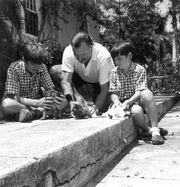
Ernest Hemingway and sons Patrick and Gregory in Cuba in 1942, playing with kittens.
In fact, Hemingway's fire extinguisher was a bomb. On his command, his men began shooting at the U-boat. Under that cover, Hemingway was able to get aboard the U-boat and drop the bomb down the hatch. Hemingway and his men survived the resulting explosion, and escaped in the Pilar. Hemingway then radioed the U-boat's position to the United States Navy, who sent a PBY Catalina out to finally sink her.
Hemingway received a hero's welcome in Havana. The Navy brought him to Washington, DC, where he received the Navy Distinguished Service Medal at a public ceremony. He also had dinner with Franklin and Eleanor Roosevelt. After brokering a book deal, he returned to Cuba.
Martha was not impressed with Hemingway's actions. She chastised him for playing at little boys' games. While he attempted to defend himself, she was so angered by his recklessness that she left him.
Ernest Hemingway in The War That Came Early[]
| The War That Came Early POD: July 20, 1936; Relevant POD: September 29, 1938 | |
| Appearance(s): | Two Fronts |
| Type of Appearance: | Contemporary reference |
Ernest Hemingway was in Madrid during the Spanish Civil War just prior to the outbreak of the Second World War in 1938. He wrote For Whom the Bell Tolls based on what he saw. It was dedicated to his wife Martha Gellhorn, who had travelled to Spain with him.[1]
Chaim Weinberg read For Whom the Bell Tolls in the summer of 1942. He and Mike Carroll discussed the fact that Hemingway, a correspondent, was now in Cuba enjoying drinks and writing books while they continued to fight. Weinberg did enjoy the novel, however. He reflected that Hemingway's protagonist, Robert Jordan, was far luckier in seeking love from a Spanish woman than was Weinberg himself.
Both Weinberg and Carroll knew soldiers who had met Hemingway while he was researching the book. The former had spoken to several who had served in the war since it had began and they all claimed that Hemingway had portrayed it accurately in his book.[2]
Ernest Hemingway in Southern Victory[]
Ernie (1899-1939) was an American author and veteran of the Great War, where he suffered a wound to his genitalia. Despondency over this injury eventually led him to alcoholism and depression. His life ended in a tragic murder-suicide.
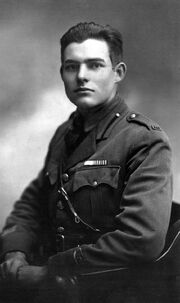
Ernie as an ambulance driver.
When the Great War broke out, Ernie joined US Army despite being underage, and sent as an ambulance driver to fighting in Quebec.[3] In June 1916, he was wounded when his ambulance, despite being marked with the Red Cross, was strafed by a Canadian aeroplane near Riviere-du-Loup in violation of the Geneva Convention. He lost much of his genitalia. Lucien Galtier witnessed this incident and was greatly shocked, later telling his friends of the "poor American soldier, whose life is ruined".[4]
| Southern Victory POD: September 10, 1862 | |
| Appearance(s): | Walk in Hell; The Center Cannot Hold; The Victorious Opposition |
| Type of Appearance: | Direct (as "Ernie") |
| Date of Death: | 1939 |
| Cause of Death: | Self-inflicted gunshot wound |
| Spouse: | None |
| Children: | None |
| Military Branch: | US Army (Great War) |
After the war Ernie moved to Boston, where he was able to publish a few novels. He was hired by Joseph P. Kennedy to help Sylvia Enos ghostwrite I Sank Roger Kimball, the story of her revenge against Confederate submersible skipper Roger Kimball, who killed her husband George after his country had already surrendered in the Great War. Sylvia was impressed by Ernie's short, clipped sentences and paragraphs, and also found herself strangely attracted to Ernie himself.[5] It was Ernie who advised Sylvia to close out her account at her bank the day before that bank closed, saving Sylvia from financial ruin.[6]
He fell on hard times thereafter, drifting from one writing job to the next and supplementing his income by taking money to be knocked out by prizefighters.[7] He and Sylvia encountered each other again and began an intimate relationship shortly thereafter.[8] Ernie's genital wound made sex difficult for him, but Sylvia was patient.[9] Nevertheless, his impotence left Hemingway depressed and embittered, and Sylvia became frightened by the intensity of Ernie's dark moods after his frequent sexual failures. At one point Ernie angrily remarked that he should go to Spain and enlist in the Civil War.[10] At other times, he spoke of suicide.
Many of Sylvia's friends and loved ones, including her son George Jr., encouraged her to leave Ernie before he harmed her.[11] But their warnings only made her more stubborn and more committed to her relationship with Ernie despite her own fears that their worries were valid. One night Ernie produced a loaded revolver after another failed attempt at sex. Sylvia tried to wrest it away from him, the gun misfired, and Sylvia was killed. Horrified, Ernie shot himself.[12]
Though Ernie did publish some stories under his own name, he never developed much of a literary career.
Literary Note[]
Harry Turtledove never uses Ernie's last name, but describes the character in sufficient enough detail to make it clear that Ernie is indeed Ernest Hemingway. Much of the character's dialogue in written in the style that Hemingway had his main characters speak in.
In OTL, Ernest Hemingway did not suffer a genital wound. However, the main character of his first major novel, The Sun Also Rises, did suffer such a wound in World War I, and a main plot element of Hemingway's book is a tragic love affair which cannot be consummated due to that wound.
See also[]
- Literary Allusions in Turtledove's Work for more general references and allusions to Hemingway and his work.
References[]
- ↑ Two Fronts, pg. 115-116.
- ↑ Ibid., pg. 116.
- ↑ Walk in Hell, pg. 273, MMP.
- ↑ Ibid. pgs. 275-277.
- ↑ The Center Cannot Hold, pg. 272-274.
- ↑ Ibid., pg. 275.
- ↑ The Victorious Opposition, pg. 39.
- ↑ Ibid., pg. 38-42.
- ↑ See, e.g. ibid., pg. 125.
- ↑ Ibid., pg. 363.
- ↑ See, e.g., ibid., pg. 364.
- ↑ Ibid., pg. 367.
| ||||||||||
| ||||||||||||||||||||||
